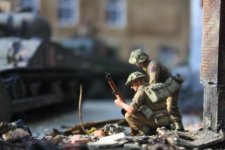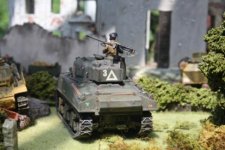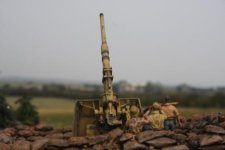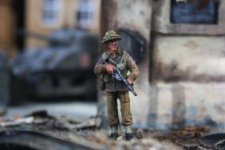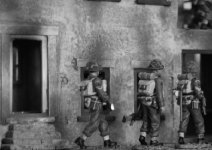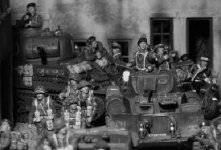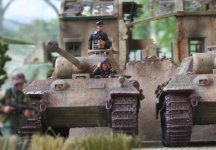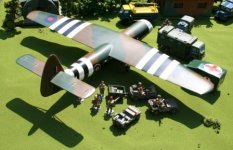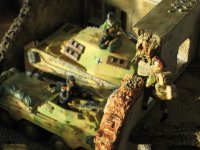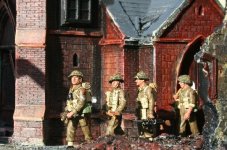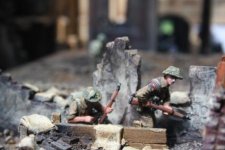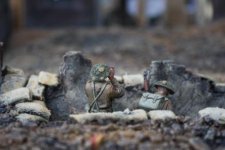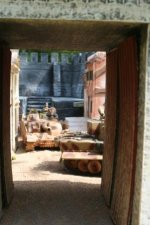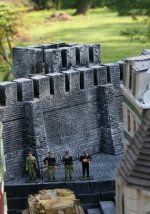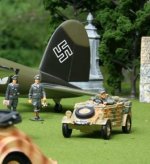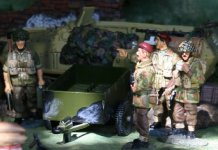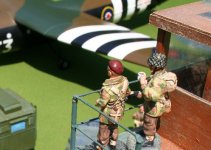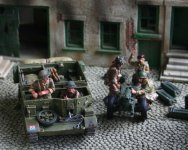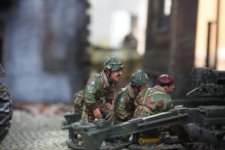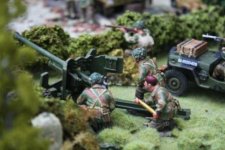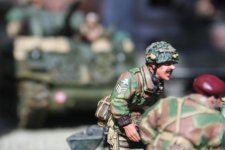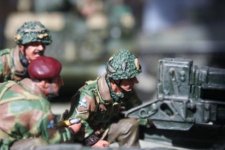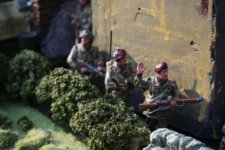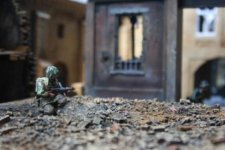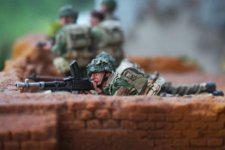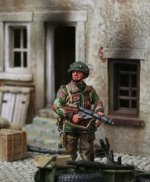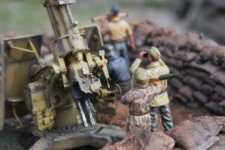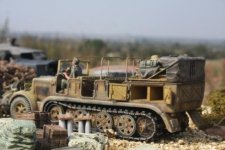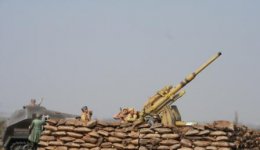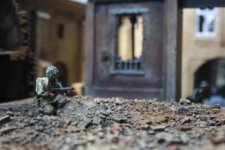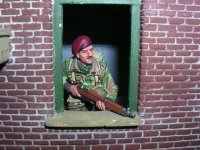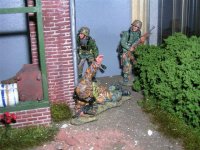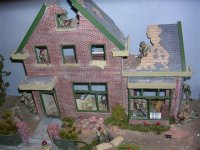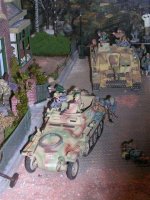II: GUN DEVELOPMENT
Development. The German 8.8 cm gun was introduced in 1934 as the standard mobile AA gun. It was then known as the 8.8-cm. Flak 18. In 1936, during the Spanish War, it proved a very effective weapon against tanks, which were at that time relatively lightly armored.
In order to develop still further this dual-purpose employment, the Germans produced armor-piercing ammunition for the weapon, a telescopic sight suitable for the engagement of ground targets, and a more mobile carriage.
An HE shell with a percussion fuse was also produced so that the weapon could, when necessary, be employed in a field artillery role. The improved equipment was ready in time for the Battle of France, when it proved itself capable of dealing with the heavier French tanks, against which the then standard AT gun, the 3.7-cm (1.45-in) PAK was relatively ineffective.
The next step was to provide the gun with a new carriage, from which the gun could engage tanks without being taken off its wheels, and to fit a shield. Still more recently, a self-propelled mount has been reported and while there is no precise information as to its design, it appears that from this mount the gun can readily take on ground, but not air, targets.
Description
(a) General. For all practical purposes, the operating characteristics of the18, 36, and 38 models of this weapon are the same. The main characteristics of the 8.8-cm Flak 18 are as follows:
-Muzzle Velocity: 2,755 f/s
-Maximum horizontal range 16,600 ft
-Maximum vertical range 35,700 ft
-Maximum effective ceiling 34,770 ft
-Theoretical rate of 25 rpm
-Practical rate of fire 12 to 15 rpm
-Weight in 4.9 tons Weight in draft . 7.1 tons
-Elevation -3 to +85 degrees
-Traverse 36 degrees (limited to two complete revolutions of the handwheels,
either side of zero, to avoid excessive twisting of the data transmission cable)
-Length of barrel . 56 cals
(b) Gun data (8.8-cm Flak 18). The gun consists of a jacket, a sleeve, a removable tube in three sections, and a breech ring. The three section tube is held in place by the breech ring in the rear and by a locking collar in the front, both of which are secured to the sleeve. The sleeve is secured to the jacket by a locking ring at the breech end. One of the joints in the three section liner is in the chamber of the gun and is therefore sealed by the shell case, but the other occurs at about one-third of the distance to the muzzle.
The breech mechanism is of the horizontal sliding wedge type, semiautomatic and self-cocking. As the gun recoils, the mechanism opens, ejects the empty case, and at the same time, compresses the striker and breechblock operating springs. Loading is by automatic rammer used in conjunction with a loading tray. Firing is by percussion.
The withdrawal of the loading tray will operate the firing mechanism unless set to "Hand." The breechblock may be opened and closed by hand if desired. The mechanism must be hand-operated for loading the first round. Safety arrangements are incorporated in the mechanism to prevent firing until the breech is in the closed position.
(c) Mount data. The mount has a platform which rests squarely on the ground when the gun is in the firing position. The platform has four legs, with jacks at the outer ends of each for approximate leveling. In the traveling position, the two side legs fold upward. The pedestal is secured to the platform and supports the body through a gimbal ring and body pivot housing.
The body, which contains the azimuth and elevation gears, supports the cradle on its trunnions and rotates in the housing for azimuth traverse. Accurate cross leveling is accomplished by rocking the body pivot housing in the gimbal ring by means of cross-leveling handwheels on the platform. A 5-degree movement is possible by this means. The gun slides on the cradle, to which it is connected through the recoil mechanism.
The recoil system incorporates a hydraulic buffer below the barrel, and a hydro-pneumatic recuperator above. Both cylinders are secured to the cradle, and the pistons are connected to the breech ring. The buffer contains 18.8 pints of buffer fluid. The recuperator contains about 4.5 gallons of fluid and an approximately equal volume of air at 39 atmospheres. Length of recoil is variable, being about 1,050 mm at 0 degrees quadrant elevation, and 4700 mm at 85 degrees quadrant elevation. The automatic milliner operates with the return cylinder, loading-tray, and actuating mechanism. The internal construction of the return cylinder resembles that of the recuperator on a smaller scale. A hand-operated fuse setter with two openings is fitted to the left side of the body.
To put the gun in traveling position, the side legs are folded upward and secured. A limber and carriage are attached to the platform, which is raised by winches and secured. Some modifications of this gun are capable of being fired from the traveling position at ground targets, and there is also a model on a self-propelled mount.
(3) Ammunition & Penetration The three types of ammunition used with this weapon are as follows :
(4) Fire control. The gun may be laid on the target by three methods :
(a) Indirect laying, by matching the pointers of the data receivers, which are controlled by the director (the Kommandogerat)
(b) Direct laying, by means of the Flak ZF 20-E telescopic sight. Vertical and lateral deflections are applied to the telescope, and the man at the azimuth handwheel puts the cross hairs on the target. The gun is elevated by the man on the elevation handwheel, who follows an indicating arm which moves with the sight.
(c) The dial sight may be used for laying the gun in azimuth, while the quadrant elevation is set in by the elevation man as ordered.
(5) Mobility. This gun is normally towed by two types of half-track vehicles. These vehicles, which are respectively of 140 and 185 horsepower and weigh 11 1/2 and 14 1/2 tons loaded, carry the gun crew, as well as a supply of ammunition in lockers at the rear of the vehicle. T he exact amount of ammunition carried is not known, but seems to be at least about 35 rounds.
(6) Personnel.
(a) For action against aircraft. The gun detachment consists of a detachment commander and nine men, with duties for antiaircraft action as follows: Detachment Commander, No.1 Elevation setter, No.2 Azimuth-setter, No. 3 Loading and firing number, No.4, & 5 Ammunition numbers, No. 6 Fuse-setter, No. 7, 8 & 9 Ammunition numbers
(b) For action against ground targets. For the engagement of ground targets, the duties of this gun detachment are as follows: Detachment Commander, No.1 Elevation setter, No.2 Azimuth-setter, No. 3 Loading and firing number, No.4, 5, 6 & 7 Ammunition numbers, No. 8 Range setter, No. 9 Lateral deflection setter
Figarti 88
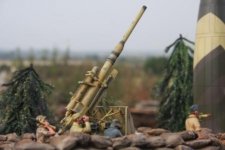
An old picture of the pioneer early K&C 88mm
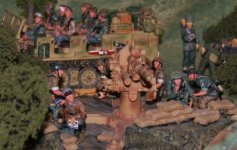
These last three posts are from
http://efour4ever.com/88.htm